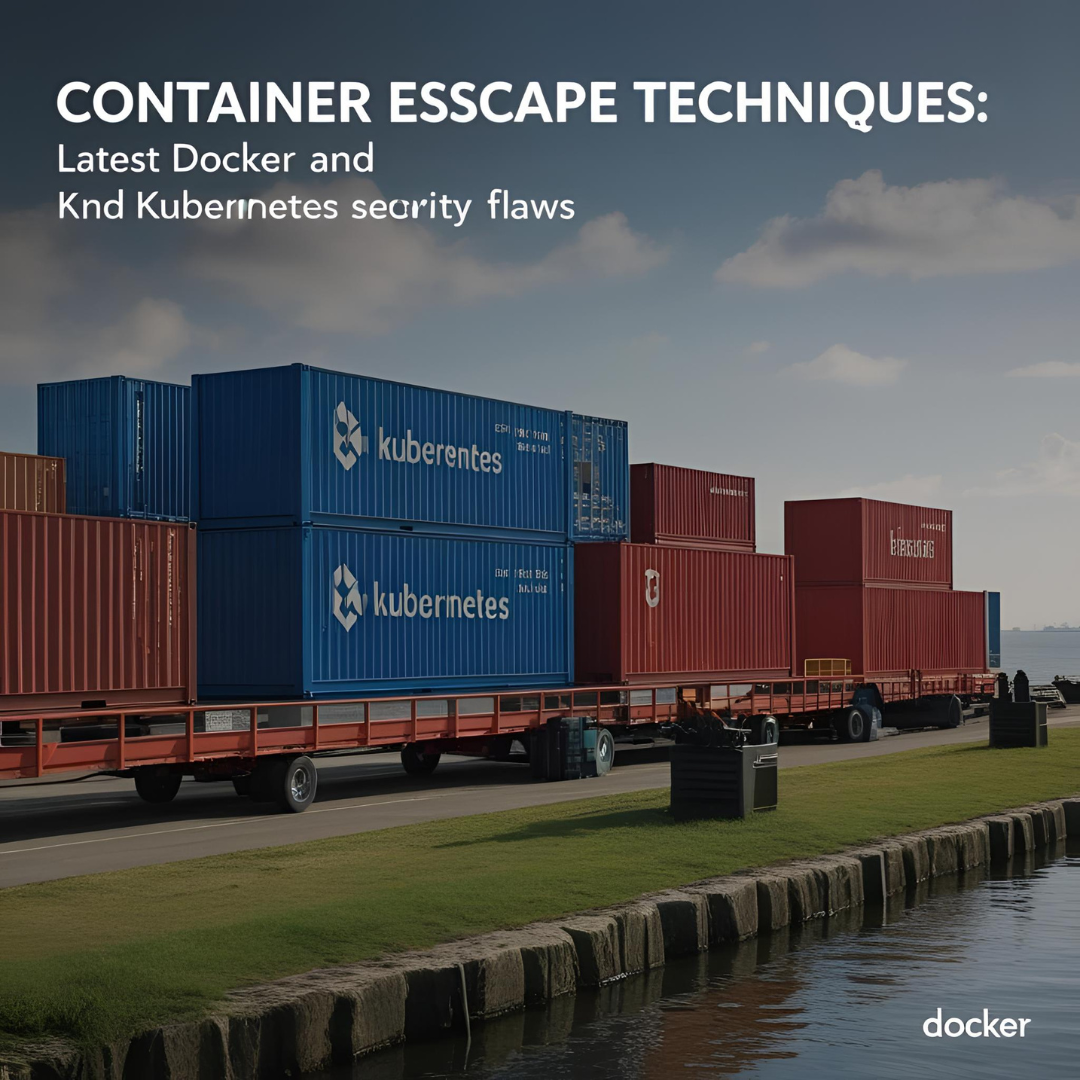Container technology has revolutionized application deployment and orchestration, with Docker and Kubernetes leading the charge in containerization adoption. However, as containers become increasingly prevalent in production environments, they also present new attack vectors that security professionals must understand and mitigate. Container escape techniques represent one of the most critical threats in containerized environments, allowing attackers to break out of container isolation and potentially compromise the host system.
Understanding Container Escape Fundamentals
Container escape occurs when an attacker successfully breaks out of the container’s isolated environment to gain access to the host operating system or other containers. Unlike traditional virtual machines that provide hardware-level isolation, containers share the host kernel, making escape techniques particularly concerning.
The Container Security Model
Modern container platforms rely on several Linux kernel features for isolation:
- Namespaces: Provide process, network, and filesystem isolation
- Control Groups (cgroups): Limit resource usage and access
- Capabilities: Fine-grained privilege control
- Seccomp: System call filtering
- AppArmor/SELinux: Mandatory access control
When these mechanisms fail or are misconfigured, container escape becomes possible.
Recent Docker Security Vulnerabilities
CVE-2024-21626: Docker Desktop Privilege Escalation
This critical vulnerability in Docker Desktop allows local attackers to gain SYSTEM privileges on Windows and root privileges on macOS and Linux systems. The flaw exists in the Docker Desktop installer and affects versions prior to 4.27.0.
Attack Vector:
- Exploitation of improper file permissions during installation
- Local privilege escalation through symlink attacks
- Potential for persistent backdoor installation
Mitigation:
- Update Docker Desktop to version 4.27.0 or later
- Implement proper file system permissions
- Monitor installation processes for suspicious activity
CVE-2024-23651: BuildKit Mount Cache Poisoning
A vulnerability in Docker’s BuildKit component allows attackers to poison mount caches, potentially leading to supply chain attacks through compromised container images.
Technical Details:
- Improper validation of mount cache entries
- Possibility of cache poisoning across different builds
- Potential for malicious code injection into seemingly trusted images
Impact:
- Supply chain compromise
- Lateral movement within container environments
- Persistent backdoor installation in base images
Runtime Escape via Privileged Containers
Recent research has highlighted ongoing risks associated with privileged container execution:
Privileged Container Risks:
# Dangerous: Running container with full privileges
docker run --privileged -it ubuntu:latest /bin/bash
# Inside container - direct host access possible
mount /dev/sda1 /mnt
chroot /mnt
# Now operating on host filesystem
Kubernetes Security Flaws and Escape Techniques
CVE-2024-21652: Kubernetes Windows Node Privilege Escalation
This vulnerability affects Kubernetes clusters running Windows nodes, allowing pod containers to escalate privileges and potentially escape to the host system.
Exploitation Method:
- Abuse of Windows-specific container runtime features
- Improper handling of Windows security contexts
- Potential for cluster-wide compromise
Detection Indicators:
- Unusual process creation on Windows nodes
- Unexpected privilege escalation events
- Anomalous network traffic from worker nodes
CVE-2023-5528: Kubernetes ValidatingAdmissionWebhook Bypass
A critical flaw in Kubernetes’ admission control mechanism allows attackers to bypass security policies and deploy malicious workloads.
Attack Sequence:
- Craft malicious pod specification with specific annotations
- Exploit race condition in webhook validation
- Deploy privileged containers bypassing security controls
- Execute container escape techniques
Service Account Token Exploitation
Recent attack patterns have focused on exploiting Kubernetes service account tokens for container escape:
Attack Chain:
# Malicious pod specification
apiVersion: v1
kind: Pod
metadata:
name: escape-pod
spec:
serviceAccountName: high-privilege-sa
containers:
- name: attacker
image: malicious-image
volumeMounts:
- name: docker-sock
mountPath: /var/run/docker.sock
volumes:
- name: docker-sock
hostPath:
path: /var/run/docker.sock
Advanced Container Escape Techniques
Docker Socket Exploitation
One of the most common escape vectors involves mounting the Docker socket inside containers:
Exploitation Process:
# Inside compromised container with docker socket access
docker run -it --rm -v /:/host ubuntu:latest chroot /host /bin/bash
# Direct host system access achieved
Detection Methods:
- Monitor for unusual Docker API calls
- Alert on container creation with host volume mounts
- Track Docker socket access patterns
Kernel Exploit-Based Escapes
Recent kernel vulnerabilities have enabled sophisticated container escapes:
CVE-2024-1086: Use-After-Free in Netfilter
- Affects Linux kernel versions 5.14 to 6.6
- Allows privilege escalation from container to host
- Exploitable through network namespace manipulation
Exploitation Indicators:
- Unusual netfilter rule modifications
- Suspicious network namespace operations
- Kernel module loading attempts from containers
Resource Exhaustion Attacks
Advanced attackers use resource exhaustion to trigger container runtime vulnerabilities:
Fork Bomb Escape Technique:
# Overwhelming cgroup limits to trigger runtime bugs
:(){ :|:& };:
# Combined with specific timing attacks on container runtime
Container Runtime Vulnerabilities
runC Security Flaws
Recent vulnerabilities in runC, the underlying container runtime:
CVE-2024-21626: File Descriptor Leak
- Allows container processes to access host file descriptors
- Potential for sensitive data exposure
- Requires specific timing conditions for exploitation
runc Path Traversal (CVE-2023-27561)
- Improper handling of symbolic links during container creation
- Allows writing to arbitrary host filesystem locations
- Can lead to complete host compromise
CRI-O and containerd Issues
Alternative container runtimes have also experienced security issues:
containerd Snapshotter Vulnerabilities
- Improper isolation between container layers
- Potential for layer poisoning attacks
- Cross-container information disclosure
Detection and Monitoring Strategies
Runtime Security Monitoring
Behavioral Analysis:
- Monitor for unusual system calls from containers
- Track privilege escalation attempts
- Detect unauthorized file system access
Key Indicators:
# Suspicious activities to monitor
- Mount operations from containers
- Attempts to access /proc/*/root
- Docker socket API calls
- Kernel module loading
- Unusual network connections from containers
Log Analysis and SIEM Integration
Critical Log Sources:
- Container runtime logs
- Kubernetes audit logs
- Host system security events
- Network traffic analysis
Alert Triggers:
- Container creation with excessive privileges
- Unexpected host volume mounts
- Anomalous process execution patterns
- Network connections to suspicious destinations
Real-time Threat Detection
EDR Integration:
- Deploy endpoint detection on container hosts
- Monitor container process trees
- Track file system modifications
- Analyze network behavior patterns
Prevention and Mitigation Strategies
Secure Container Configuration
Principle of Least Privilege:
# Secure pod specification example
apiVersion: v1
kind: Pod
metadata:
name: secure-app
spec:
securityContext:
runAsNonRoot: true
runAsUser: 1000
fsGroup: 2000
containers:
- name: app
image: app:latest
securityContext:
capabilities:
drop:
- ALL
add:
- NET_BIND_SERVICE
readOnlyRootFilesystem: true
allowPrivilegeEscalation: false
Runtime Security Controls
Policy Enforcement:
- Implement Pod Security Standards
- Use OPA Gatekeeper for policy enforcement
- Deploy Falco for runtime security monitoring
- Configure seccomp and AppArmor profiles
Network Segmentation:
- Implement network policies
- Use service mesh for encrypted communication
- Deploy micro-segmentation strategies
- Monitor east-west traffic patterns
Image Security Best Practices
Supply Chain Security:
- Implement image signing and verification
- Use minimal base images
- Regular vulnerability scanning
- Enforce image provenance tracking
Build Security:
# Secure Dockerfile example
FROM ubuntu:22.04-slim
RUN groupadd -r appgroup && useradd -r -g appgroup appuser
COPY --chown=appuser:appgroup app /app/
USER appuser
EXPOSE 8080
CMD ["/app/start"]
Incident Response for Container Escapes
Detection and Containment
Immediate Response Steps:
- Isolate affected nodes from the cluster
- Preserve forensic evidence from container logs
- Analyze runtime security tool alerts
- Identify the scope of potential compromise
Forensic Analysis:
- Container image analysis
- Runtime behavior reconstruction
- Network traffic examination
- Host system integrity verification
Recovery Procedures
Clean Recovery Process:
- Rebuild compromised nodes from known-good images
- Rotate all secrets and service account tokens
- Update container images and runtime components
- Implement additional security controls
- Conduct thorough security assessment
Emerging Threats and Future Considerations
Serverless Container Attacks
New attack vectors targeting serverless container platforms:
- Function-as-a-Service (FaaS) escape techniques
- Cold start exploitation methods
- Shared runtime environment attacks
AI/ML Workload Security
Container escape techniques targeting AI/ML workloads:
- GPU-enabled container vulnerabilities
- Model extraction through container escape
- Training data exfiltration methods
Supply Chain Integration Attacks
Advanced persistent threats targeting container supply chains:
- Registry compromise and image tampering
- Build pipeline infiltration
- Dependency confusion in container builds
Best Practices Summary
Organizational Security Measures
Governance and Compliance:
- Establish container security policies
- Implement regular security assessments
- Maintain compliance with industry standards
- Conduct regular penetration testing
Training and Awareness:
- Educate development teams on container security
- Provide security training for operations staff
- Establish secure development practices
- Create incident response procedures
Technical Implementation
Defense in Depth:
- Implement multiple security layers
- Use runtime security tools
- Deploy network monitoring solutions
- Maintain comprehensive logging
Continuous Improvement:
- Regular security tool updates
- Vulnerability management programs
- Threat intelligence integration
- Security metrics and reporting
Conclusion
Container escape techniques continue to evolve as attackers develop new methods to bypass container isolation mechanisms. The recent vulnerabilities in Docker and Kubernetes demonstrate that even mature platforms require constant vigilance and proactive security measures.
Organizations deploying containerized applications must implement comprehensive security strategies that address both known vulnerabilities and emerging threats. This includes maintaining up-to-date container runtimes, implementing proper security controls, and establishing robust monitoring and incident response capabilities.
The key to effective container security lies in understanding that containers are not inherently secure and require deliberate security measures throughout their lifecycle. From secure image creation to runtime monitoring and incident response, every aspect of container deployment must be designed with security in mind.
As container technology continues to mature, security professionals must stay informed about the latest threats and continuously adapt their defensive strategies. The battle between attackers and defenders in the container space is ongoing, making continuous learning and improvement essential for maintaining secure containerized environments.
By implementing the strategies and best practices outlined in this post, organizations can significantly reduce their risk of successful container escape attacks while maintaining the agility and efficiency benefits that containerization provides.


Leave a Reply